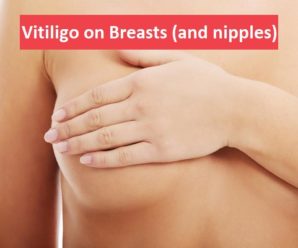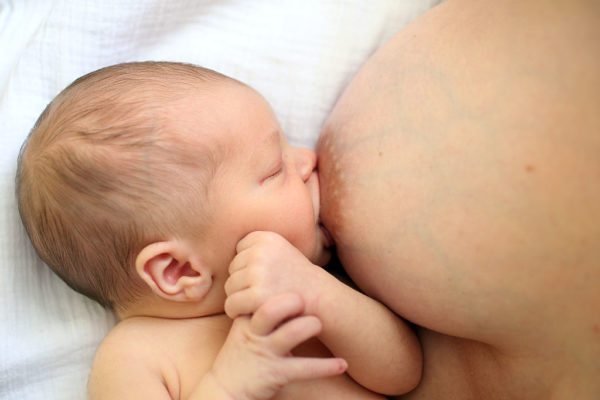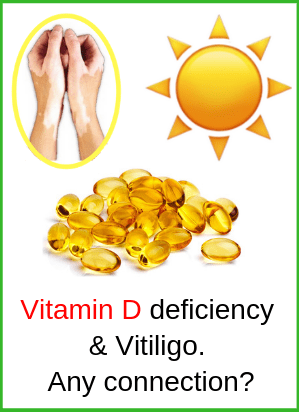
Vitiligo on Breasts (and Nipples)- An Overview
Vitiligo patches can develop literally anywhere on the whole body. However, the body parts frequently exposed to sunrays (such as face, lips, neck, hands, feet, elbows, wrists, knees, genitals) and the body’s natural folds (such as armpits, groin, eyelids, genital area) are more prone to develop vitiligo lesions. If you have got vitiligo patches on other body parts, then it can spread to the breasts (including areola and nipple area) also. However, it is quite rare that vitiligo starts from breasts.
Melanocytes are the skin cells that provide pigment (natural color) to our skin. In case of Vitiligo (leucoderma), the faulty, confused immune system attacks these melanocytes and damage (destroy) them to cause skin depigmentation in the form of white spots on various parts of the body.
Vitiligo is not life-threatening; also, completely non-contagious in nature. However, being related to a faulty immune system, it may increase the chances of other health issues over the period of time if effective steps are not taken to regulate the immune system.
For those who are not aware, there is a long list of autoimmune disorders, including type 1 diabetes, rheumatoid arthritis, psoriasis, inflammatory bowel disease, and vitiligo. In today’s competitive world, due to a hectic lifestyle and stress, more and more people are getting affected by autoimmune disorders. The immune system’s primary job is to protect the human body from external disease causing threats, but, in case of autoimmune disorders, it goes into the ‘auto’ mode and starts attacking the body’s own cells instead.
The exact cause of autoimmunity could not be established yet and there can be a collection of factors which may trigger the immune system. The most prominent reasons include:
- Chronic stress (1)
- Poor gut health (chronic constipation and indigestion, lack of healthy gut microbes, low stomach acid, impaired liver) (2)
- Faulty genes (hereditary)
- Skin injuries and skin trauma (such as surgery)
- Respiratory system infections such as strep throat
- Excessive use of steroids and antibiotics
- Unhealthy diet and poor, disturbed lifestyle
- Alcohol abuse
- Severe nutritional deficiency
- Heavy metal toxicity due to contaminated drinking water and pesticide residues in food
Vitiligo on Breasts (and nipples)
Some of the major skin trauma events that trigger vitiligo spots on breasts are: –
- During pregnancy, vitiligo can spread to breasts and abdomen area. It can be due to the skin trauma resulting out of skin distension and striae formation on the breasts and the abdomen.
- During breastfeeding, if the baby is not latching on to the breast properly, it will cause pain, swelling, cracks and other damages to your nipples and areola area. All this skin trauma may trigger the immune system to develop vitiligo spots on nipples and surrounding area.

- Breast surgery such as reconstruction, augmentation or reduction.
- Any kind of breast injury or physical trauma. For example, blow to the breasts during sports, running or jogging without supportive bra and wearing a tight top often. Wearing poorly fitted bra can also cause discomfort and skin trauma as the skin of the breast area is quite sensitive and responsive.
Got Vitiligo on Breasts? Some useful precautions
To manage vitiligo lesion on breasts, people generally apply topical steroids (creams) or use UV light therapy. If you are also using the same strategies, then below precautions would be handy for you-
- Avoid excessive use of steroidal creams– Various topical corticosteroids such as betamethasone valerate, clobetasol propionate and hydrocortisone are applied externally on vitiligo spots to suppress the immune system and keep a check on further spreading. However, corticosteroids abuse to get quick results is harmful. It can cause skin thinning, redness and increased sensitiveness. The skin of breast area is already quite sensitive and thin. Hence, self-medication is not advised here. Use a mild corticosteroid as suggested by your doctor and follow the instructions carefully.
For sensitive areas like breasts, underarms, and genitals, many of the dermatologists recommend Tacrolimus. It is as effective as a mild potency steroid with lesser side effects such as skin thinning or other issues. (3, 4)
- Prefer light therapy under medical supervision– UV light therapy is also very popular in treating vitiligo lesions on the breast area. But, the chances of side effects such as skin burning due to over exposure or penetration of UV rays in harmful ranges is higher because the skin of the breast area is quite sensitive and thin. So, better you take light therapy under medical supervision than at home.
- Reduce artificial chemicals exposure– Check for artificial chemicals in all the personal hygiene and cosmetic products that you use, such as shower gel, bathing soap, shampoo and breast massage cream. Many of these chemicals act as catalyst for autoimmunity and can worsen vitiligo symptoms over a period of time. (5, 6) Choose natural (herbal) products instead.
- Pregnant or breastfeeding women need extra precautions– Pregnant and nursing women strictly should not try any of the medical treatments without a registered medical practitioner’s diagnosis.
The takeaway message
Treat the skin of your breast area well and protect it from skin trauma, injuries and exposure to artificial chemicals.
Before wrapping it up, the most important thing that I want to emphasize here is- improve your gut health if you want to achieve long term, stable improvement in vitiligo symptoms. Actually, more than 70% of the immune system cells lies in the gut, hence, restoring the gut health should be the top most priority to reverse this autoimmune reaction.
Consume a healthy diet compromising of easy-to-digest, whole foods. Your diet should comprise of 40-50% vegetables, 15-20% fruits, 15-20% grains and legumes and remaining 10-15% can be animal proteins (dairy, meat, fish and eggs).
Adopt a stress-free, positive lifestyle- sound sleep, regular meal timings, regular physical workout and balance between professional and personal life.
Oral consumption of anti-inflammatory, gut healing herbs and dietary supplements like turmeric (curcumin), neem, milk thistle, omega 3 fatty acids, vitamin D, vitamin B12, glutamine and gut probiotics is also very crucial.
Practicing yoga, meditation, pranayam and stress management techniques can do wonders as well because stress is one of the most common triggers for vitiligo.



